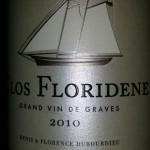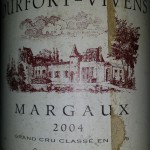![20150111_212736[1]](http://www.bordeauxwineblog.com/wp-content/uploads/2015/01/20150111_2127361-e1421417468812-168x300.jpg)
I have been a fan of Clos Dady for a while. This 6-hectare estate in Preignac was recently purchased by the Russian Eli Ragimov. It is currently managed in conjunction with nearby Château d’Arche.As opposed to the red wines of Bordeaux, 2007 is a good year for sweet white wines, and this comes through in 2007 Clos Dady, which I enjoyed with panfried foie gras – a marriage made in heaven…
The color is a rich deep golden yellow with bronze highlights. The nose is very fresh and fruity with quince and (decided) pear aromas, with some waxy nuances. The bouquet seems much more overripe than botrytized.
The taste goes from round and unctuous into a finish with pronounced acidity. The aftertaste is pleasant, but on the short side.
This is nevertheless a good wine to enjoy at this stage of its development. It is fresh and vital. I am of the opinion that there is a style of Sauternes (like this) that appeals more to the French market, as opposed to the other kind (more botrytized, more concentrated, and oaky) that appeals to foreign markets. At table, even so, this Clos Dady was a treat.
![20150111_212328[1]](http://www.bordeauxwineblog.com/wp-content/uploads/2015/01/20150111_2123281-e1421417965630-168x300.jpg)
I expected much from the 2002 Ch. Troplong Mondot, a wine that I do not follow regularly, but which was promoted to Premier Grand Cru status in 2006 and confirmed in 2012. Aware that 2002 is not such a wonderful vintage, especially on the Right Bank, I was willing to make allowances. I was nevertheless disappointed with what I tasted. The color is lovely and deep, looking younger than its age. The nose has hints of leather and musk as well as a ferrous, and what I call a soy sauce element. It is ripe and shows candied fruit. Things unfortunately go downhill from there… The wine is simply steamrollered by the oak.
One of the great discussions among Bordeaux lovers is the “classic” versus the “modern” style. I freely admit to belonging more to the former camp. Still, I have an open mind. But when a wine is as overwhelmed as this by barrel ageing, you simply have to admit it. 2002 Troplong Mondot is thus big and a little “hot” on the palate with a hard, dry, oaky aftertaste. It is curiously diluted on the attack, and then goes dumb and tight. The wine showed a little better after a few hours in the decanter, but it is going nowhere. Someone was a just a little too ambitious that year in light of the fruit’s potential.
The last Troplong Mondot I had was a 1990, which was delightful, so I do not mean to paint every vintage with the same brush by any means.
Also, I am anxious to go to the restaurant that recently opened at Troplong Mondot, called Les Belles Perdrix. I’ve heard very good reports…
The Bordeaux rumor mill has been very active with news of a possible takeover of the estate since Christine Valette passed away last year, but these seem to be ungrounded.
![20150111_212534[1]](http://www.bordeauxwineblog.com/wp-content/uploads/2015/01/20150111_2125341-e1421417487557-168x300.jpg)
I am increasingly finding that mid-range 2000 Bordeaux is ready to drink. So, I decanted a bottle of 2000 Ch. Siran to have with rabbit à la moutarde. I should point out that the mustard ends up being very subtle when blended with the cooking juices and cream, so this did not really skew my evaluation. Anyway, the color of this 2000 Siran is very deep and thick, looking younger than its years. The nose is surprisingly mute. Although pure, it is not very expressive at all. What little I could detect smelled like beetroot. The wine is somewhat better on the palate and reminded me of nothing so much as the way Médoc used to taste when I first arrived in Bordeaux, over 30 years ago. I noted cedar and a touch of blackcurrant, but also unquestionable greenness and bitterness on the finish. I came back to the wine 5 hours after the meal, and it had changed little. The tealike flavors are very reminiscent of old-fashioned Médoc. Above all, this wine would have been much better a few years ago. You’d have to look very hard to find any of the characteristics usually associated with Margaux…

![20150118_174649[1]](http://www.bordeauxwineblog.com/wp-content/uploads/2015/01/20150118_1746491-e1421602751948-168x300.jpg)
![20150111_212736[1]](http://www.bordeauxwineblog.com/wp-content/uploads/2015/01/20150111_2127361-e1421417468812-168x300.jpg)
![20150111_212328[1]](http://www.bordeauxwineblog.com/wp-content/uploads/2015/01/20150111_2123281-e1421417965630-168x300.jpg)
![20150111_212534[1]](http://www.bordeauxwineblog.com/wp-content/uploads/2015/01/20150111_2125341-e1421417487557-168x300.jpg)
![20150107_084747[1]](http://www.bordeauxwineblog.com/wp-content/uploads/2015/01/20150107_0847471-e1421009398195-150x150.jpg)

